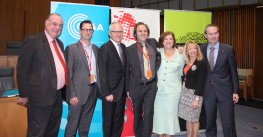
Community Radio: a key part of free-to-air digital
On 3 September 2014, the CBAA and sector bodies representing community broadcasters gathered for morning tea with Federal politicians to continue to highlight the role of community broadcasting services in Australian media.
Later that day Minister for Communications Malcolm Turnbull, spoke with The Wire about developments for digital radio.
The Minister restated the Government’s support for community radio:
'We’re very supportive of the presence of community radio stations on digital radio, and we’ll coordinate with the industry to ensure that community radio is a part of any future digital radio framework…’
He acknowledged the role of community radio in regional areas:
'Community radio is a very valuable platform to communicate to our constituents and is often the only media available to regional and remote communities.'
He also stressed the role of commercial ‘viability’ in the rollout of digital radio:
'The rollout of digital radio, outside of where it currently is, is really a commercial decision for broadcasters and it depends on the viability of services being made available in markets that are big enough to sustain them.'
A recent industry report released by Commercial Radio Australia shows the take up of digital radio is performing strongly. Across the five cities, 21.4% of all radio listening per week is by DAB+ digital radio, people listen for an average of 9.5 hours each week and the number of digital radio receivers sold now exceeds 1.8 million. Almost 100,000 new vehicles have been sold with DAB+ and 16 vehicle manufacturers include digital radio as either standard or an option for the Australian market.
The age range of digital radio listening is very evenly spread, with the following percentages listening to DAB+:
- 22.8% of 10-17 year olds
- 17.5% of 18-24 year olds
- 20.9% of 25-39 year olds
- 22.4% of 40-55 year olds
- 22.2% of 55+ year olds
Listening to radio online (all forms fixed and mobile) was reported at 11%, an increase from 2013 at 7.7%. Online listening time is shorter and remains the same as last year at 5.5 hours per week.
The CBAA made a ![]() Community_Broadcasting_Association_of_Australia_CommunityDigitalRadio.pdf to the Federal Government reviews of digital radio in March 2014 that focused on a number of key areas, including that:
Community_Broadcasting_Association_of_Australia_CommunityDigitalRadio.pdf to the Federal Government reviews of digital radio in March 2014 that focused on a number of key areas, including that:
EXAMPLE re: email - e.g. Contact us for more info... when email added Contact Us changes to email address i.e. Contact Us
- An industry planning group be established for the rollout of digital radio co-ordinated by the ACMA
- A staged approach be implemented for regional digital radio services commencing 2016-17
- Sub-metropolitan and remote community radio services are included in planning considerations
- Triggers for analogue closure be based on all forms of digital listening reaching over 50% with 95% coverage
- Planning for regional digital radio be based on licence areas with shared infrastructure, coverage alignment and deeming greater than 25%
- Digital broadcast capacity is needed to address concurrent audience demand for radio services
- Inclusion of services is based on concurrent audience and evidence based on a per service basis
- The provision of digital radio broadcast services on a free-to-receive basis functions in the public interest, provides media diversity and achieves cultural inclusion objectives
- Current legislation provides two-ninths of category 1 or 2 foundational multiplex access to community broadcasters
- Additional multiplexes should be declared foundational until community services reach parity access with other broadcast sectors and until then additional capacity should be reserved for community broadcasters from any excess capacity
- Regional trials should reserve two-ninths capacity for community broadcasters in accordance with digital radio legislation
- The access regime for digital radio continue to be administered by the ACCC with some amendments
- Provision for community broadcasters to initiate multiplexes be introduced and otherwise the moratorium should end by June 2015
- In the contemporary media environment the digital delivery of radio is no longer an optional approach
- Free-to-receive broadcast platforms are required as mainstay services
- Boutique and interactive on-demand broadband platforms are complementary to broadcast services
- Hybrid solutions would ideally be available seamlessly on user devises
- Broadcasters maintain responsibilities to operate in the public interest and for social benefit
- A primary set of free-to-receive digital radio services should be available to the full Australian community
The CBAA is currently working on establishing a framework with commercial and national broadcasters for the inclusion of community broadcasters in current regional digital radio trials.
Read more information on digital community radio services.
Facebook comments